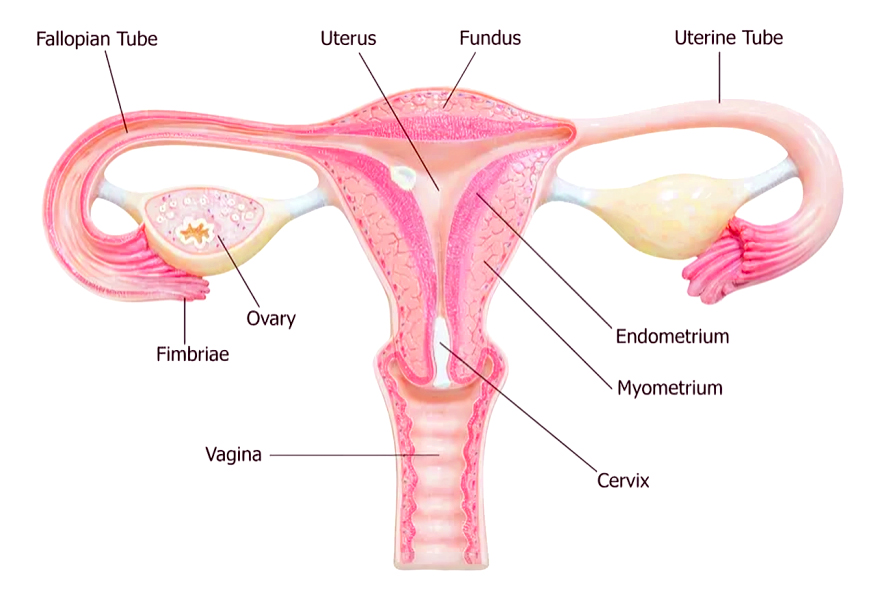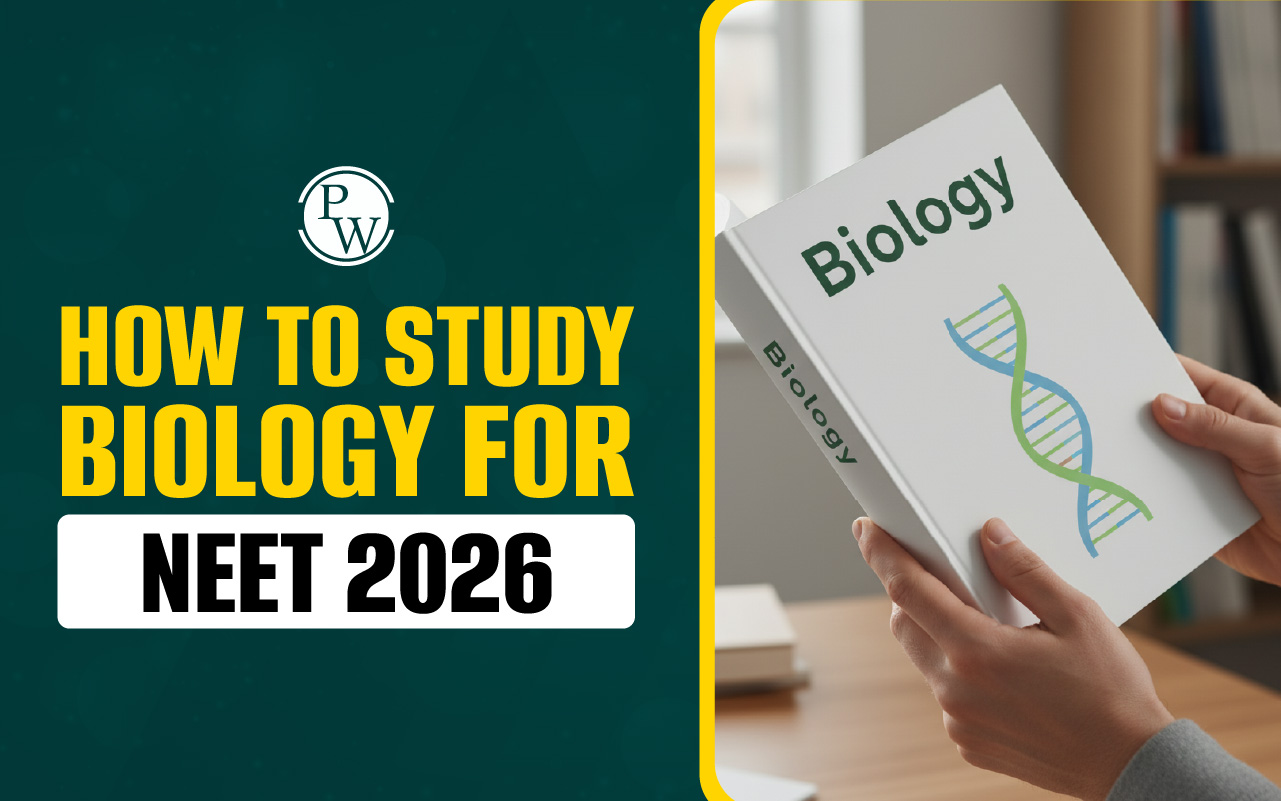
Ovary: The ovary is an essential organ in the female reproductive system. It is responsible for generating eggs and producing vital hormones. The ovary comprises an outer cortex and an inner medulla, which contain specialized units known as ovarian follicles, where eggs mature. During a process termed folliculogenesis, these follicles progress to release eggs during ovulation.
Moreover, the ovary functions as an endocrine gland, secreting hormones such as estrogen, progesterone, and androgens. Estrogen is crucial for developing secondary sexual characteristics and preparing the uterus for pregnancy. It is mainly synthesized within ovarian follicles. Progesterone is primarily produced by the corpus luteum post-ovulation and maintains the uterine lining. Androgens include testosterone. It also contributes to female reproductive processes. Read this article to get complete details about the ovary. NEET Biology Notes on the ovary, which is an important topic in the chapter on the reproductive system, are provided below.Ovary Diagram
Ovary labelled diagram is as follows
Anatomy of the Ovary
The ovary is located in the pelvic area near the uterus. It is responsible for producing eggs and releasing them for potential fertilization. It consists of an outer layer called the cortex and an inner portion known as the medulla. Within the cortex are specialized structures called ovarian follicles, where eggs develop. Blood vessels and lymphatic vessels supply nutrients and oxygen to the ovary and help remove waste products. The complete anatomy of the ovary is as follows.External Structure
The external structure of the ovary is situated in the pelvic cavity adjacent to the uterus. It comprises its location and size. It is positioned on either side of the uterus. The ovary is connected to the broad ligament via the mesovarium and linked to the uterus by the ovarian ligament. The complete external structure of the ovary is given below.- Location within the Female Reproductive System: The ovary is positioned in the pelvic cavity on either side of the uterus. It is attached to the back of the broad ligament of the uterus via the mesovarium and linked to the uterus by the ovarian ligament.
- Size and Shape: The ovary's size and shape can vary among individuals and change over a woman's life. Usually, it is about 2-4 cm long and has a shape resembling an almond. However, these dimensions can fluctuate based on factors like age, hormones, and reproductive status.
Internal Structure
The ovary is composed of the outer cortex and inner medulla. The cortex houses ovarian follicles essential for egg development, while the medulla contains connective tissue, blood vessels, and lymphatic vessels. The complete internal structure of the ovary is given below.- Ovarian Cortex and Medulla : The ovary is divided into two main parts: the outer cortex and the inner medulla. The cortex contains ovarian follicles, which are crucial for egg development. The medulla, located deeper, consists of connective tissue, blood vessels, and lymphatic vessels.
- Ovarian Follicles : Ovarian follicles are specialized structures within the cortex that nurture developing eggs. Each follicle consists of an immature egg surrounded by supportive cells. These follicles progress through stages called folliculogenesis, leading to the release of a mature egg during ovulation.
- Ovarian Stroma : The ovarian stroma is the supportive tissue surrounding the follicles, providing structural support to the ovary. It includes connective tissue, blood vessels, and lymphatic vessels, which supply nutrients and oxygen to the developing follicles.
- Blood and Lymphatic Vessels : The ovary is highly vascularized, meaning it has an extensive network of blood vessels supplying nutrients and oxygen to the ovarian tissue. Lymphatic vessels also play a role in immune function and fluid drainage within the ovary.
Functions of Ovary
The ovary is essential in female reproduction, producing eggs and hormones that are important for fertility. The functions of the ovary are vital for grasping its significance in women's reproductive health. The complete functions of the ovary are as follows:Production of Oocytes (Eggs)
The ovary is a dynamic organ responsible for oocyte (egg) production. It is facilitated by two main processes: oogenesis and folliculogenesis.- Oogenesis : Oogenesis refers to the process of egg development within the ovary. It starts before birth and continues throughout a woman's reproductive life. It involves the transformation of precursor cells called oogonia into mature eggs or ova.
- Folliculogenesis : Folliculogenesis is the process of ovarian follicle development and maturation. Ovarian follicles are specialized structures containing immature eggs surrounded by supporting cells. Each month, several follicles begin to develop, but usually, only one fully matures and releases its egg during ovulation.
Hormone Production
The ovaries play a vital role in hormone production. It releases key hormones essential for reproductive function and overall health.- Estrogen : Estrogen is a hormone primarily produced by the ovarian follicles. It plays a vital role in developing secondary sexual characteristics and regulating the menstrual cycle. Estrogen promotes the growth of the uterine lining, preparing it for potential pregnancy.
- Progesterone : Progesterone is produced mainly by the corpus luteum. It formed from the remnants of the follicle after ovulation. Progesterone supports the thickened uterine lining during the second half of the menstrual cycle (luteal phase) and prepares the uterus for embryo implantation and pregnancy.
- Androgens : Androgens, including testosterone, are hormones produced in small amounts by the ovaries. They contribute to various aspects of female reproductive function, such as libido and ovarian regulation.
Sexual Reproduction in Flowering Plants
Role of Ovary in the Menstrual Cycle
The ovary's involvement in the menstrual cycle is crucial for reproductive function and fertility. It encompasses key phases:- Follicular Phase : The follicular phase marks the beginning of the menstrual cycle, characterized by the development of ovarian follicles under the influence of follicle-stimulating hormone (FSH). Estrogen produced by the growing follicles stimulates the thickening of the uterine lining.
- Ovulation : Ovulation occurs around the middle of the menstrual cycle, triggered by a surge in luteinizing hormone (LH). It involves the release of a mature egg from the ovary into the fallopian tube, where it can be fertilized by sperm.
- Luteal Phase : Following ovulation, the remaining follicle transforms into the corpus luteum, which produces progesterone. Progesterone maintains the thickened uterine lining, preparing it for potential embryo implantation. If pregnancy does not occur, the corpus luteum degenerates, hormone levels decrease, and menstruation begins again, initiating a new menstrual cycle.
Structural Organisation in Animals
Regulation of Ovarian Function
The ovaries are essential for fertility and are regulated by hormones like FSH and LH from the HPG axis. It is influenced by age, environment, and lifestyle. The regulation of ovarian function is explained below.Hormonal Regulation and Control
The regulation of ovarian function involves complex hormonal processes produced by the hypothalamic-pituitary-gonadal (HPG) axis.- Hypothalamic-Pituitary-Gonadal Axis : The hypothalamic-pituitary-gonadal (HPG) axis is a hormonal system that oversees ovarian function. It starts with the hypothalamus, which releases gonadotropin-releasing hormone (GnRH). GnRH stimulates the anterior pituitary gland to secrete follicle-stimulating hormone (FSH) and luteinizing hormone (LH). FSH and LH act on the ovaries to regulate follicle development, ovulation, and hormone production.
- Feedback Mechanisms : Feedback mechanisms help maintain hormonal balance within the HPG axis. Negative feedback loops control FSH and LH release by the pituitary gland in response to estrogen and progesterone levels. Elevated estrogen inhibits FSH, while high progesterone levels suppress LH, aiding menstrual cycle regulation.
Factors Influencing Ovarian Function
Various factors, including age, environmental conditions, and lifestyle choices, can influence ovarian function. All aspects are explained below.- Age : Ovarian function is age-dependent, with ovarian reserve and hormone production declining over time. This decline correlates with reduced follicle quantity and quality, ultimately leading to menopause.
- Environmental Factors : Environmental elements, like pollutants and toxins, can impact ovarian health. Certain substances, such as endocrine-disrupting chemicals (EDCs), may disrupt hormone production and ovarian function.
- Lifestyle Factors : Lifestyle choices, including diet, physical activity, and stress levels, can influence ovarian function. Unhealthy eating habits, sedentary behaviour, and chronic stress disrupt hormonal equilibrium and menstrual regularity. Conversely, adopting a balanced diet, engaging in regular exercise, and managing stress can support optimal ovarian function and reproductive well-being.
Common Ovarian Disorders
Ovarian disorders encompass a range of conditions affecting women's reproductive health. These disorders can disrupt normal ovarian function. It leads to various symptoms and complications. The common ovarian disorders are detailed below.- Polycystic Ovary Syndrome (PCOS) : PCOS is a hormonal disorder characterized by irregular menstrual periods, excess androgen levels, and polycystic ovaries. Symptoms include irregular periods, acne, excessive hair growth, and infertility.
- Ovarian Cysts : Ovarian cysts are fluid-filled sacs that form on the ovaries. Most cysts are harmless and resolve on their own, but some may cause pain or complications if they rupture or become enlarged.
- Ovarian Cancer : Ovarian cancer is a type of cancer that begins in the ovaries. It often goes undetected until it has spread within the pelvis and abdomen, making it difficult to treat.
- Premature Ovarian Failure : Premature ovarian failure (POF), also known as premature menopause, occurs when the ovaries stop functioning before the age of 40. It leads to infertility and symptoms similar to menopause, such as hot flashes and vaginal dryness.
| NEET Exam Important Links | |
|---|---|
| NEET Biology Syllabus | NEET Biology Diagrams |
| NEET Biology MCQ | NEET Biology Chapter wise Weightage |
| NEET Biology Notes | NEET Previous Year Question papers |
Ovary FAQs
Q 1. What are the functions of the ovary?
Ans. The ovaries play vital roles in female reproductive health. They produce and store eggs (ovum) and secrete hormones that regulate the menstrual cycle and support pregnancy. During ovulation, one ovary releases an egg, which, if fertilized by sperm, can lead to pregnancy.
Q 2. What is the ovary body type?
Ans. The "ovary body type" or "ovary belly" is a condition primarily seen in females, characterized by weight gain in the lower belly and thigh areas. It is often associated with an excess of the hormone estrogen and tends to be more pronounced during hormonal fluctuations such as menstruation or after childbirth.
Q 3. Which ovaries get pregnant?
Ans. Right-sided ovulation may have a slightly higher chance of resulting in pregnancy compared to left-sided ovulation.
Q 4. What is an ovary fruit?
Ans. Ovary fruit refers to the mature reproductive structure of a plant, formed from the ovary of a flower. Fruits contain seeds and aid in their dispersal. They play a crucial role in plant reproduction and are often consumed by animals or humans as food.
🔥 Trending Blogs
Talk to a counsellorHave doubts? Our support team will be happy to assist you!

Check out these Related Articles
Free Learning Resources
PW Books
Notes (Class 10-12)
PW Study Materials
Notes (Class 6-9)
Ncert Solutions
Govt Exams
Class 6th to 12th Online Courses
Govt Job Exams Courses
UPSC Coaching
Defence Exam Coaching
Gate Exam Coaching
Other Exams
Know about Physics Wallah
Physics Wallah is an Indian edtech platform that provides accessible & comprehensive learning experiences to students from Class 6th to postgraduate level. We also provide extensive NCERT solutions, sample paper, NEET, JEE Mains, BITSAT previous year papers & more such resources to students. Physics Wallah also caters to over 3.5 million registered students and over 78 lakh+ Youtube subscribers with 4.8 rating on its app.
We Stand Out because
We provide students with intensive courses with India’s qualified & experienced faculties & mentors. PW strives to make the learning experience comprehensive and accessible for students of all sections of society. We believe in empowering every single student who couldn't dream of a good career in engineering and medical field earlier.
Our Key Focus Areas
Physics Wallah's main focus is to make the learning experience as economical as possible for all students. With our affordable courses like Lakshya, Udaan and Arjuna and many others, we have been able to provide a platform for lakhs of aspirants. From providing Chemistry, Maths, Physics formula to giving e-books of eminent authors like RD Sharma, RS Aggarwal and Lakhmir Singh, PW focuses on every single student's need for preparation.
What Makes Us Different
Physics Wallah strives to develop a comprehensive pedagogical structure for students, where they get a state-of-the-art learning experience with study material and resources. Apart from catering students preparing for JEE Mains and NEET, PW also provides study material for each state board like Uttar Pradesh, Bihar, and others
Copyright © 2025 Physicswallah Limited All rights reserved.
Get App









